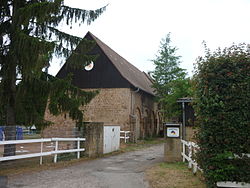Rothenkirchen Monastery
| Rothenkirchen Monastery | ||
|---|---|---|
 The former refectory |
||
| Data | ||
| place | Kirchheimbolanden | |
| Client | Premonstratensians | |
| Architectural style | Late Romanesque | |
| Construction year | around 1160 | |
| demolition | 1961 except for the refectory and the remains of the cloister | |
| Coordinates | 49 ° 41 '0.3 " N , 7 ° 57' 59" E | |
|
|
||
The Rothenkirchen Monastery ( Monasterium Rubrense ) is a former Premonstratensian monastery in the municipality of Kirchheimbolanden . It is located at the Rothenkircherhof estate in the northwest of the city in the Palatinate Bergland . The monastery has been a listed building since 1999.
history
The monastery was founded around 1160 and settled from the nearby Hane Monastery . Hane Monastery was founded around 1120 by Werner I. von Bolanden as an Augustinian canons monastery and soon became a double monastery in which sisters also settled. The Haner Konvent joined the order of the Premonstratensians around 1135. The sisters from Hane moved some time later - according to Michael Frey in 1160 - to Rothenkirchen. There the Premonstratensians bought a chapel of the Neumünster Monastery (near today's Ottweiler ) with accessories and built their own convent for them. The purchase of the Neumünster goods was confirmed by the Archbishop of Mainz, Arnold von Selenhofen († 1160). Around 1180, both convents changed their seat, so that from now on the Premonstratensians lived in Rothenkirchen monastery and the sisters again in Hane; Pope Lucius III confirmed this exchange in 1182, as did Archbishop Conrad I von Wittelsbach in 1189.
The complex, which was already seen as shabby in the late Middle Ages, was looted in the Peasants' War in 1525. The liquidation took place in 1554. Subsequently, the monastery complex passed into Nassau ownership as an estate . The facility was devastated during the Thirty Years' War . The owners have changed several times since 1821. With the exception of the late Romanesque refectory, a residential building from 1854 and the remains of the cloister, the complex was demolished in 1961. In 1990 it became the property of the city. There is a riding stables on the monastery grounds.
Buildings and plant
The refectory , built around the year 1200 - a clear two-aisled hall that is 25.02 meters long and 8.40 meters wide - has two six square bays with heavily busted cross vaults over bulging ribs . The walls are built in good ashlar from red sandstone. The capitals , built in the Strasbourg-Worms type, are to be emphasized, which show spiral volutes above a wreath of broad-lobed leaves , between which flat palmette patterns fill the gusset . On the south wall there is a niche for lecturers between strong buttresses. A round-arched portal leads to the former cloister on the north side , of which only shield arches and stepped pillar templates (similar to Eusserthal Monastery ) are left. The tympanum is framed on the lintel by the inscription: “Hanc domum fecerunt Werner et Guda”, which refers to Count Werner II of Bolanden from the noble family of the Lords of Bolanden .
The refectory used as a storage room is a consistently high-quality building in the style of the Upper Rhine-Worms late Romanesque and is also a monument of high regional historical value.
Parts of the architecture have found their way into the museum in Kirchheimbolanden.
literature
- References from Norbert Backmund: Monasticon Praemonstratense , Volume 1, Berlin 1983, pp. 117-118.
- Georg Dehio (abbreviation): Handbook of German art monuments. Rhineland-Palatinate. Saarland , edited by Hans Caspary, Wolfgang Götz and Ekkart Klinge, Munich / Berlin: Deutscher Kunstverlag 1972, pp. 367–368.
- Dethard von Winterfeld : The Kaiserdome Speyer, Mainz, Worms and their Romanesque area , Würzburg 1993, Echter Verlag, ISBN 3-429-01489-1 , pp. 327–329 with plate 94.
Individual evidence
- ↑ Website on Neumünster Monastery ( Memento of the original from July 21, 2015 in the Internet Archive ) Info: The archive link was automatically inserted and not yet checked. Please check the original and archive link according to the instructions and then remove this notice.
- ^ Website on Rothenkirchen Monastery
- ↑ Michael Frey : Attempt at a geographical-historical-statistical description of the royal Bavarian Rhine district , Volume 1, Speyer 1837, p. 241 u. 260; (Digital scan 1) , (Digital scan 2)
- ^ Adolph Köllner: History of the rule Kirchheim-Boland and Stauf , Wiesbaden, 1854, p. 17; (Digital scan of the confirmation of the exchange of 1180)
- ^ Dehio / Gall: Pfalz and Rheinhessen. Munich and Berlin: Deutscher Kunstverlag, 1951, p. 124
